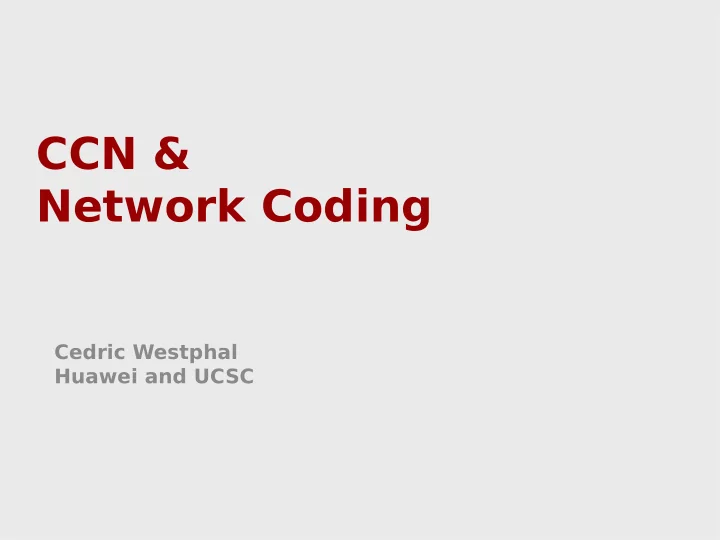

CCN & Network Coding Cedric Westphal Huawei and UCSC
ICN & Network Coding - RFC7933 9.5. Network Coding for Video Distribution in ICN An interesting research area for combining heterogeneous sources is to use network coding [Montpetit13b]. Network coding allows for asynchronous combining of multiple sources by having each of them send information that is not duplicated by the other but that can be combined to retrieve the video stream. However, this creates issues in ICN in terms of defining the proper rate adaptation for the video stream, securing the encoded data, caching the encoded data, timeliness of the encoded data, overhead of the network coding operations both in network resources and in added buffering delay, etc. Network coding has shown promise in reducing buffering events in unicast, multicast, and P2P settings. [Medard12] considers strategies using network coding to enhance QoE for multimedia communications. Network coding can be applied to multiple streams, but also within a single stream as an equivalent of a composable erasure code. Clearly, there is a need for further investigation of network coding in ICN, potentially as a topic of activity in the research group. - M-J. Montpetit, C. Westphal, D. Trossen, Network Coding Meets Information- Centric Networking, in Proc. Workshop on Emerging Name-Oriented Mobile Networking (NoM'12), ACM MobiHoc, June 2012 - J. Saltarin, E. Bourtsoulatze, N. Thomos, T. Braun, NetCodCCN: a Network Coding approach for Content Centric Networks, IEEE Infocom 2016 - A. Ramakrishnan, C. Westphal, J. Saltarin, Adaptive video streaming over CCN with network coding for seamless mobility, IEEE ISM 2016
Background on ICN (well, CCN) CCN has been around ten years; will become experimental RFC in the ICNRG working group (last call issued yesterday) Key principles of ICN: ● Two types of messages, Interest and Data formats ● Interest(name) request the data; Data(name) returns the data as payload
Processing of Interest at Router Data structures at router: ● Content store (that is, content cache/bufger) ● Pending Interest Table (PIT, that keep tracks of the oustanding interests and allow the return of the data) ● FIB (name-based) Source: PARC
Network Coding & CCN Since Interests can be sent over multiple interfaces, it would be benefjcial that they return difgerent data if both hit the requested data → send request for coded chunks Idea fjrst discussed in “Network Coding Meets ICN”:
Benefjts ICN benefjts: Sessionless transport of ICN; Connect to content directly; Mobility Support; Native multicasting; Leverage of ubiquitous caching + Network coding benefjts: Asynchronous use of multiple interfaces/paths jointly If interest is multicast to multiple sources, returned data is not lost but can be cached closer to the requester Populate the cache faster if multiple clients request the same data Preserve the 1-interest-1-data fmow balance of CCN
NetCodCCN ( Saltarin et al ) Instead of requesting a specifjc segment, request a coded segment, without specifying a specifjc segment id Naming: fjle /provider/videos/largevideo.h264 is partitioned into K generations of H segments: /provider/videos/largevideo.h264/k/1000 for generation k and coding vector [1,0,0,0] Interest have a NetworkCodingAllowed bit in the interest header Modifjed procedure at router of Interests with NetworkCodingAllowed turned on Modifjed procedure for data (in particular to match data with Interests for coded segments)
NetCodCCN ( Saltarin et al ) Interests are not fjltered out in the same manner , depends on a function of the oustanding interests for coded segments
Video Streaming ( Ramakrishnan et al ) DASH rate adaptation: measure the bandwidth by the time to download the current segment; adapt the rate of the next segment accordingly We aligned the generation of the coded segments with the DASH segments Computed pre-encoding for all DASH rates at the server We were able to show, using NetCodCCN implementation: ● Little degradation in performance due to network coding overhead ● Rate adaptation on the logical link (composed of multiple paths over multiple interface) ● Seamless session mobility
Next Steps “Network Coding Meets ICN” has received some attention and there seem to be some interest in this space What does this RG intend to do? Collaboration with ICNRG possible?
Recommend
More recommend